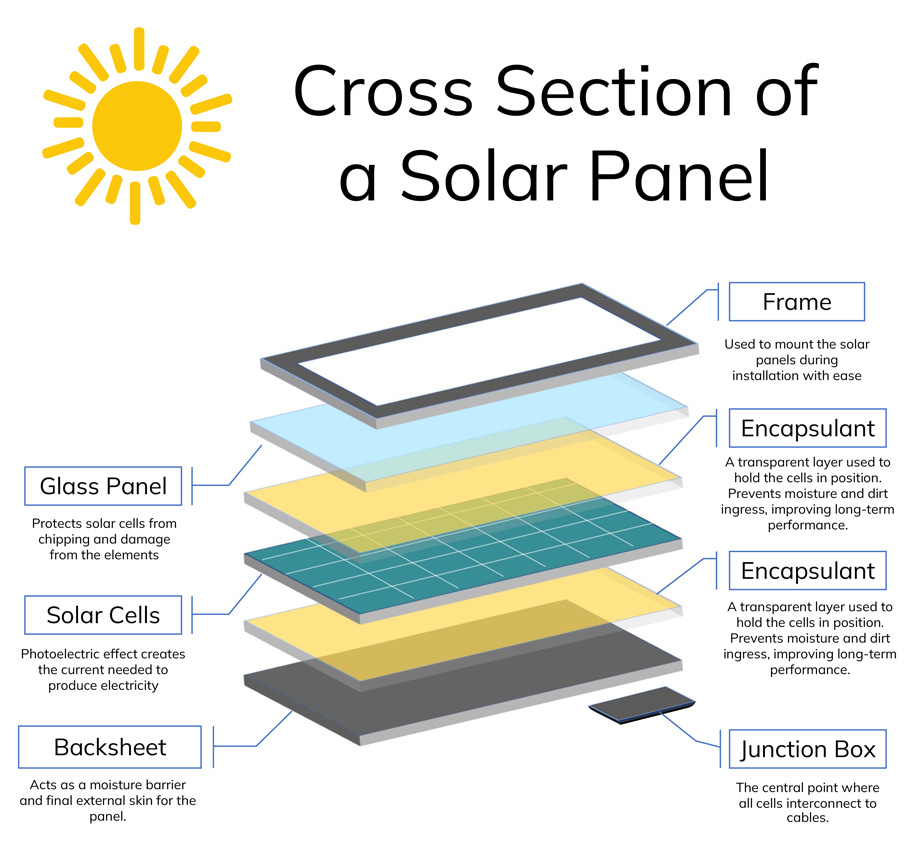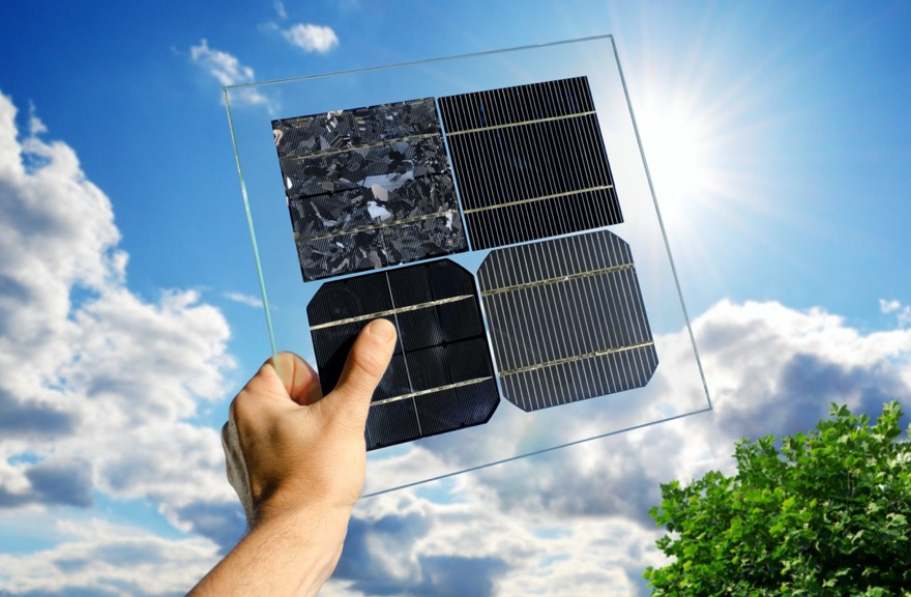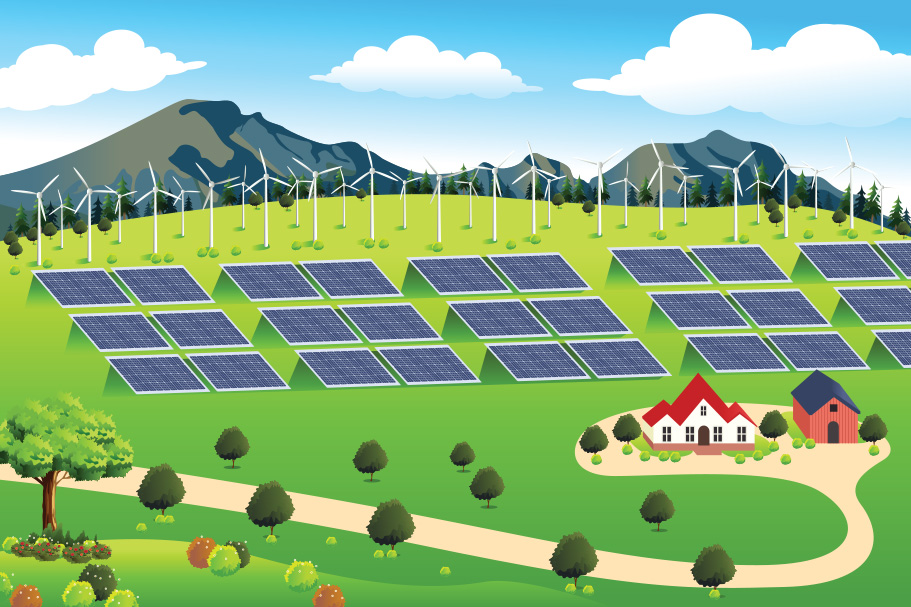By Shauna
May 3, 2022
The threat of climate change has become impossible to ignore and consumers are increasingly seeking renewable energy sources to reduce their carbon footprints. A popular choice would be solar energy – today, solar panels crown rooftops, roadside signs and even help to power spacecraft.
But how do they work? We explore the anatomy of solar panels and how they produce renewable energy to combat climate change.

Recipe for Solar Panels – What Are They Made Up Of?
Solar Cells and Silicon Layers
Solar panels generate electricity from UV lighting even in cloudy conditions – they are made out of solar cells, that convert the sun's energy into electricity.
Solar cells are sandwiched between layers of semi-conducting materials like silicon. Each layer has different electronic properties that are energised when hit by photons from sunlight, creating an electric field. This creates the current needed to produce electricity and is known as the photoelectric effect.
Metal Backing and Conducting Strips
Each individual solar cell is a small square or rectangle and these flat pieces are assembled together with silver strips that connect and conduct all the electricity to a central location. On top of these conductive metal strips, the solar cells also receive a metal backing.
Typical solar panels today consist of either 60 or 72 of these cells assembled together. From there, the electricity travels away from the panel, toward other parts of a solar energy system such as battery storage or an inverter.
Anti-reflective Layers
An anti-reflective film is applied to the top of each solar cell to improve the panel's efficiency. Without this, more of the light would be reflected away instead of being absorbed straight into the silicon. This layer is often made of titanium oxide or silicon nitride.
Glass and Frames
A layer of glass is added over the collection of solar cells to protect them from chipping and other kinds of damage from the elements.
Frames are also used to mount solar panels during installation with ease, therefore making installation and maintenance less labour-intensive. They are often made of aluminium and interface with the rest of the mounting structure needed to create a sturdy solar power array.

Different Types of Solar Panels – Materials and Appearances
In Singapore today, there are three main types of solar panels available in the market – monocrystalline, polycrystalline and thin-film solar panels. Each type has its pros and cons and is made utilising different materials. As such, the outer appearance of each type of solar panel is also different. Here is a quick summary of their differences.

• Monocrystalline
The characteristic appearance of the monocrystalline solar panel is a dark exterior. This is due to the way that sunlight interacts with the material of the solar panel.
Although the colour of monocrystalline solar cells cannot be changed, their frames and back sheets are highly customisable. Additionally, the solar cells are square-shaped with rounded edges, causing small gaps between each cell.
Monocrystalline solar panels are made from silicon, specifically silicon sheets. The Czochralski method is used in the manufacturing process of these solar panels where a pure silicon crystal is set into a tank of molten silicon at high temperatures. This results in thinly sectioned silicon sheets. These sheets are then made into the solar cell and assembled together to form one solar panel.

• Polycrystalline
Unlike monocrystalline cells, polycrystalline solar cells are blue and marbled. They are also square without gaps or spaces between them.
Similar to their monocrystalline counterparts, polycrystalline solar panels are also made of silicon sheets. However, polycrystalline panels are made from multiple crystals instead. The manufacturing process also involves a silicon crystal placed into a tank of molten silicon. Yet, instead of removing the crystal, the silicon is left to fragment and cool. Once cooled, the newly fragmented crystal is sliced into sheets and assembled rectangularly to form a panel.

• Thin-film Solar
Thin-film solar panels can come in both blue and black shades, depending on the material used during manufacturing. As the name suggests, they are significantly thinner (approximately 350 times) compared to other solar panel types.
Made with a variety of materials, they are produced by placing a thin layer of one or more films of photovoltaic matter onto a solid surface like glass. Examples of these photovoltaic materials include silicon, cadmium or copper.


Recent Innovations: What The Future Holds For Solar Technology
With solar technology constantly evolving, there also has been numerous solar innovations that have surfaced recently.
• Building-integrated Photovoltaic (BIPV) Technology
BIPV technology refers to solar power generating products or systems that are seamlessly integrated into the building envelope and components. This translates to the generation of clean energy, as well as savings in the form of material costs since builders can effectively eliminate the cost for separate solar mounting systems.
• Perovskite Solar Cells
The energy conversion efficiency of traditional silicon solar cells is reaching its natural limits. Efforts have thus been made to explore new materials with the potential to improve energy conversion rates. One such promising option includes emerging silicon-perovskite photovoltaic cell technology.
Much like silicon solar cells, perovskite solar cells can efficiently convert ultraviolet and visible light into electricity. They are also relatively inexpensive and approximately 500 times thinner than silicon – not only are they a cost-effective alternative, but are also flexible and ultra-lightweight. While the technology is still new to the market, it is only a matter of time before they become a viable option for commercial solar.
These are exciting times for the renewable energy industry! While most of the solar panels in Singapore today are deployed on rooftops and largely out-of-sight, that could likely change in the near future as more innovative deployment options and innovations are explored. It also seems likely that solar panels will transform not just the architectural appearances of our homes but more broadly, the way energy is generated and consumed. It is a future that promises to be greener, one that we are all striving aggressively towards.